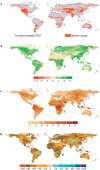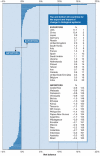Exporting the ecological effects of climate change. Developed and developing countries will suffer the consequences of climate change, but differ in both their responsibility and how badly it will affect their ecosystems
- PMID: 18578020
- PMCID: PMC3327550
- DOI: 10.1038/embor.2008.42
Exporting the ecological effects of climate change. Developed and developing countries will suffer the consequences of climate change, but differ in both their responsibility and how badly it will affect their ecosystems
Figures









References
-
- Cramer W et al. (2001) Global response of terrestrial ecosystem structure and function to CO2 and climate change: results from six dynamic global vegetation models. Glob Chang Biol 7: 357–373
-
- Franco AMA, Hill JK, Kitschke C, Collingham YC, Roy DB, Fox R, Huntley B, Thomas CD (2006) Impacts of climate warming and habitat loss on extinctions at species' low-latitude range boundaries. Glob Chang Biol 12: 1545–1553
-
- Gerten D, Schaphoff S, Haberlandt U, Lucht W, Sitch S (2004) Terrestrial vegetation and water balance: hydrological evaluation of a dynamic global vegetation model. J Hydrol 286: 249–270
-
- Hickler T, Prentice IC, Smith B, Sykes MT, Zaehle S (2006) Implementing plant hydraulic architecture within the LPJ dynamic global vegetation model. Glob Ecol Biogeogr 15: 567–577
-
- Hickling R, Roy DB, Hill JK, Fox R, Thomas CD (2006) The distributions of a wide range of taxonomic groups are expanding polewards. Glob Chang Biol 12: 450–455
Publication types
MeSH terms
Substances
LinkOut - more resources
Full Text Sources

